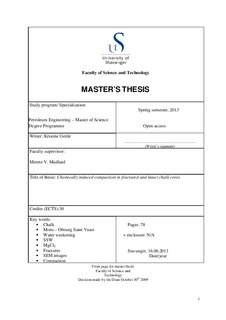| dc.description.abstract | The effect of pore water chemistry on the mechanical strength of chalk has been thoroughly investigated during the last years. Recent studies have demonstrated precipitation of new minerals that further triggers dissolution and increased deformation of chalk matrix when exposed to certain brines at reservoir temperatures. However, to detect these newly formed minerals and further localize the areas of precipitation by analyzing SEM (scanning electron microscopy) images, have proved to be a time-consuming and complicated process.
Until now, most research have been carried out on intact chalk cores while only minor attention have been devoted to study fractured cores. In this thesis, high porosity outcrop chalk from Mons was tested experimentally in triaxial cells - both fractured and intact. The temperature was kept at a constant value of 130°C (similar to reservoir conditions) and the cores were flooded with different types of brines; either synthetic seawater (SSW) or magnesium chloride (0.219M MgCl2). Two mechanical tests were conducted; hydrostatic and creep, and effluent water was collected during this whole testing period. By analyzing the amount of ions present in the effluent made it possible to confirm if the injected brine was diffusing into the matrix, and not only through the fracture itself. SEM images would further support the overall observations provided from the experimental results.
The experimental work showed that the fractures did not have any remarkable effect on the mechanical strength during hydrostatic loading, were all cores were flooded with 0.657M NaCl. The small differences that occurred however, are most likely caused by variations in porosity values rather than the fractures. Also during the first 6 days of creep, it was continued to flood with 0.657M NaCl and all the cores witnessed of relatively similar behaviors, with a reduction in strain rate and further development of transient creep phase. When the flooding brines were substituted, more distinct observations could be seen. The cores flooded with SSW experienced the highest deformation rates despite that one core contained a fracture whereas the other one was intact, but the latter had a somewhat higher value when comparing the two. Similar behaviors were observed for the cores flooded with 0.219M MgCl2, as the intact core had a slightly higher deformation rate. The reason for the increased deformation rate observed for the intact cores, was suggested to be a result of the core matrix being immediately contacted by the flooding fluid. For the cores containing fractures, the brine would spend longer time to diffuse into the matrix and hence deform the chalk core.
Chemical analysis of the effluent water have shown that magnesium is lost within the core in addition to calcium production, both for the fractured and intact cores when flooded with SSW and 0.219M MgCl2. SEM images from one of the fractured cores also detected clay like minerals in the hole’s wall and it was clear that the grain structure had been altered. Images from further out in the core exterior on the other hand, had cleaner grain surface as it was possible to see the coccolith rings. | no_NO |
